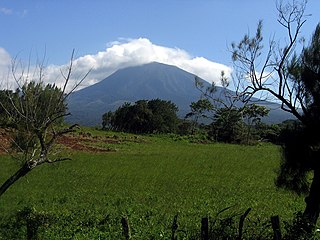
Guanacaste National Park, in Spanish Parque Nacional Guanacaste is a national park in northern Costa Rica. The park is part of the Area de Conservación Guanacaste World Heritage Site, and stretches from the slopes of the Orosí and Cacao volcanoes west to the Interamerican Highway where it is adjacent to the Santa Rosa National Park. It was created in 1989, partially due to the campaigning and fund-raising of Dr. Daniel Janzen to allow a corridor between the dry forest and rain forest areas which many species migrate between seasonally. The park covers an area of approximately 340 square kilometers, and includes 140 species of mammals, over 300 birds, 100 amphibians and reptiles, and over 10,000 species of insects that have been identified. It was this high density of bio-diversity that encouraged the Costa Rican government to protect this area. The Guanacaste National Park weaves the neighboring Santa Rosa National Park with the high altitude forests of the two volcanoes, Orosi and Cacao, and the rainforest of the Caribbean in the country's north.

Guanacaste Conservation Area is an administrative area which is managed by the Sistema Nacional de Areas de Conservacion (SINAC) of Costa Rica for conservation in the northwestern part of Costa Rica. It contains three national parks, as well as wildlife refuges and other nature reserves. The area contains the Area de Conservación Guanacaste World Heritage Site, which comprises four areas.
Asturodes is a genus of snout moths in the subfamily Spilomelinae of the family Crambidae. The genus is placed in the tribe Margaroniini.
Parataxonomy is a system of labor division for use in biodiversity research, in which the rough sorting tasks of specimen collection, field identification, documentation and preservation are conducted by primarily local, less specialized individuals, thereby alleviating the workload for the "alpha" or "master" taxonomist. Parataxonomy may be used to improve taxonomic efficiency by enabling more expert taxonomists to restrict their activity to the tasks that require their specialist knowledge and skills, which has the potential to expedite the rate at which new taxa may be described and existing taxa may be sorted and discussed. Parataxonomists generally work in the field, sorting collected samples into recognizable taxonomic units (RTUs) based on easily recognized features. The process can be used alone for rapid assessment of biodiversity.
An all-taxa biodiversity inventory, or ATBI, is an attempt to document and identify all biological species living in some defined area, usually a park, reserve, or research area. The term was coined in 1993, in connection with an effort initiated by ecologist Daniel Janzen to document the diversity of the Guanacaste National Park in Costa Rica.
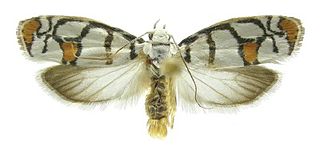
Ethmia blaineorum is a moth in the family Depressariidae. It is found in Costa Rica, where it has been recorded from the Pacific side of Cordillera de Guanacaste at altitudes ranging from sea level to 600 meters. The habitat consists of dry forests.
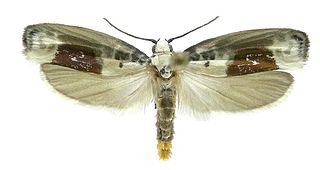
Ethmia millerorum is a moth in the family Depressariidae. It is found in Costa Rica, where it has been recorded from 1,150 to 1,300 meters in the Cordillera Volcánica de Guanacaste. The habitat consists of rain forests.

Ethmia adrianforsythi is a moth in the family Depressariidae. It is found in Costa Rica, where it has been recorded from middle elevations on the Caribbean slope of the Cordillera Volcánica de Guanacaste and in the lowlands of Sarapiquí. The habitat consists of rain forests.
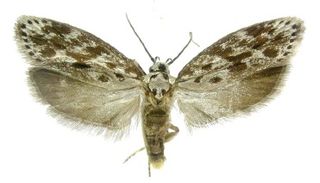
Ethmia dimauraorum is a moth in the family Depressariidae. It is found in Costa Rica, where it has been recorded at altitudes between 700 and 1,300 meters on the Pacific slope of the Cordillera de Guanacaste, at 750 meters (2,460 ft) in the Cordillera Central and at 1,000 meters (3,300 ft) at the Caribbean side of the Cordillera de Tilarán.

Ethmia helenmillerae is a moth in the family Depressariidae. It is found in Costa Rica, where it has been recorded from the Pacific slope of the Cordillera de Guanacaste at altitudes ranging from 0 to 579 meters. The habitat consists of dry forests.

Ethmia johnpringlei is a moth in the family Depressariidae. It is found in northern Costa Rica, where it has been recorded from the western sides of the Cordillera de Guanacaste at altitudes between 300 and 600 meters. The habitat consists of dry forests and rain forests.

Ethmia laphamorum is a moth in the family Depressariidae. It is found in Costa Rica, where it has been recorded from both slopes of the Cordillera Volcánica de Guanacaste and Península de Nicoya at altitudes between 20 and 600 meters. The habitat consists of dry forests.

Ethmia turnerorum is a moth in the family Depressariidae. It is found in Costa Rica, where it has been recorded from both sides of the Cordillera Volcánica de Guanacaste at altitudes ranging from 242 to 832 meters. The habitat consists of dry forests and rain forests.

Ethmia hendersonorum is a moth in the family Depressariidae. It is found in Costa Rica, where it has been recorded from the Caribbean slope at an altitude of 600 meters (2,000 ft). The habitat consists of dry forests.

Ethmia tilneyorum is a moth in the family Depressariidae. It is found in Costa Rica, where it has been recorded from the Pacific slope of the Cordillera Volcánica de Guanacaste and on the Península de Nicoya at altitudes between 50 and 160 meters. Its habitat consists of dry forests.
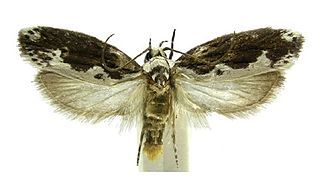
Ethmia miriamschulmanae is a moth in the family Depressariidae. It is found in Costa Rica, where it has been recorded from the Pacific side of the Cordillera Volcánica de Guanacaste and on the Península de Nicoya at altitudes ranging from 25 to 700 meters. The habitat consists of dry forests.
Jennifer S. Powers is an American ecologist and full professor in the departments of ecology, evolution and behavior, and plant and microbial biology at the University of Minnesota. Powers' research has advanced the understanding of global change consequences, ecosystem ecology, restoration and conservation of tropical dry forests. She also has been very active on several editorial boards, and in 2019 became the editor-in-chief of Biotropica, a scientific journal from the Association of Tropical Biology and Conservation (ATBC).

Winifred Hallwachs is an American tropical ecologist who helped to establish and expand northwestern Costa Rica's Área de Conservación Guanacaste (ACG). The work of Hallwachs and her husband Daniel Janzen at ACG is considered an exemplar of inclusive conservation.
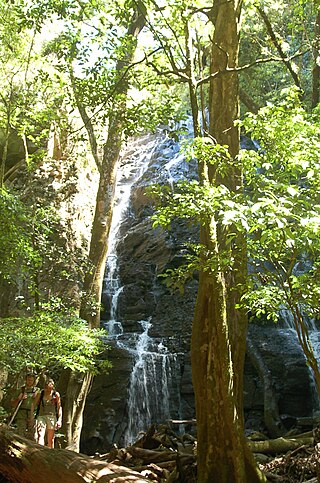
Reforestation efforts are being made in Costa Rica to recondition its biodiversity and ecosystems that were affected by heavy deforestation in the 1900s.

Robert Mitchell Pringle is an American biologist and conservationist.















